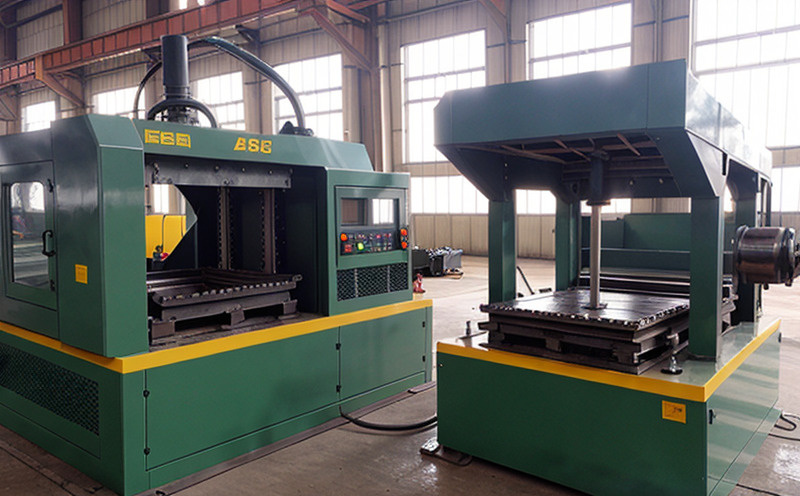DIN 50125 Geometry of Forged Test Specimens
The DIN 50125 standard is a critical component in ensuring the integrity and quality of forged parts used in industrial manufacturing. This standard specifies the geometric requirements for test specimens that are intended to represent real forgings. The primary purpose of this testing methodology is to validate the forging process, ensure compliance with design specifications, and verify the mechanical properties of materials under realistic conditions.
The geometry of the specimen plays a crucial role in accurately reflecting the stress conditions encountered by the forged part during its service life. By adhering to DIN 50125, manufacturers can ensure that their test specimens are representative of the actual components they produce, thus enabling accurate and reliable testing results.
Forging is one of the oldest manufacturing processes used in industrial production. It involves shaping metal by applying compressive forces using a die or hammer, which results in the creation of complex shapes with high mechanical integrity. The geometry of the test specimens produced under DIN 50125 ensures that the testing conditions closely mimic those experienced during actual forging operations.
The standard covers various aspects including dimensions, tolerances, and surface finish requirements for different types of forgings such as round bars, plates, and forgings with complex geometries. These specifications are designed to minimize any discrepancies between test specimens and actual components, thereby enhancing the validity of testing results.
DIN 50125 is widely recognized across Europe and beyond due to its stringent requirements which ensure high-quality standards for forged parts. Compliance with this standard is essential not only for meeting regulatory requirements but also for maintaining a reputation for excellence in product quality.
Understanding the geometric parameters outlined by DIN 50125 is vital for any organization involved in industrial manufacturing, especially those dealing with complex forgings that must meet strict performance criteria. Adherence to these standards helps manufacturers produce reliable products that can withstand harsh operational environments, thereby reducing maintenance costs and enhancing safety.
For organizations aiming to comply with DIN 50125, selecting appropriate test specimens is crucial. This involves careful selection of materials, precise measurement techniques, and adherence to strict tolerances during specimen preparation. The process demands advanced equipment such as coordinate measuring machines (CMMs) and other precision instruments capable of capturing accurate dimensions.
The testing procedures prescribed by DIN 50125 involve subjecting the prepared specimens to various mechanical tests designed to assess their strength, ductility, hardness, and fracture behavior. These tests provide valuable insights into how well a particular material or design will perform under real-world conditions.
By following DIN 50125 guidelines during specimen preparation and testing, manufacturers can ensure that their products meet the highest quality standards demanded by industries ranging from automotive to aerospace. This commitment not only enhances product reliability but also fosters trust among customers who rely on consistently high-quality components for their operations.
In conclusion, DIN 50125 is an indispensable tool in ensuring the quality of forged parts used across various industrial sectors. Its comprehensive approach to defining geometric requirements for test specimens ensures that manufacturers can produce reliable products capable of withstanding demanding operational conditions.
Why Choose This Test
Selecting DIN 50125 geometry for forged test specimens offers numerous advantages over alternative testing methods. One key benefit is its ability to provide accurate and representative results by closely mirroring the actual forging process. This ensures that the test conditions accurately reflect those experienced during manufacturing, leading to more reliable predictions about product performance.
Another advantage of using DIN 50125 lies in its strict adherence to international standards which promote consistency across different laboratories and facilities. Compliance with these standards helps maintain uniformity in testing methods, reducing variability between results obtained from various sources. This is particularly important for organizations engaged in global supply chains where consistent quality assurance practices are crucial.
Furthermore, DIN 50125 emphasizes the importance of precise specimen preparation which contributes significantly to accurate test outcomes. The detailed specifications provided by this standard guide laboratories and manufacturers through every step of specimen creation from raw material selection to final inspection ensuring that no detail is overlooked in achieving optimal results.
A third advantage pertains to regulatory compliance. Many industries require that their suppliers meet specific standards set forth by governing bodies such as DIN for certain types of forgings. By choosing DIN 50125 geometry, manufacturers not only enhance product quality but also demonstrate commitment to meeting these regulatory requirements thereby gaining competitive advantages in the marketplace.
The fourth benefit is related to improved reliability and safety. Products tested according to DIN 50125 are more likely to perform consistently under real-world conditions because they have been subjected to rigorous testing procedures that simulate actual usage scenarios. This increases confidence both among manufacturers who produce these components as well as end-users who depend on them for critical applications.
Lastly, selecting DIN 50125 geometry allows organizations to enhance their reputation by demonstrating a commitment to excellence in quality assurance practices. Companies known for producing forgings that meet or exceed international standards tend to attract more business opportunities due to increased customer trust and satisfaction levels.
International Acceptance and Recognition
DIN 50125 enjoys widespread acceptance within the European Union and other regions around the world. Its rigorous requirements have earned it a reputation for excellence among industrial manufacturers, quality assurance professionals, and regulatory bodies alike.
- Regulatory Compliance: Many countries recognize DIN 50125 as an authoritative standard for forged test specimens, making compliance essential for those operating in markets where such recognition is required.
- Market Advantage: Using this standard provides a competitive edge by ensuring that products meet or exceed international quality standards, thereby enhancing marketability and customer confidence.
- Consistency Across Borders: DIN 50125 ensures consistent testing methods across different countries and laboratories, facilitating smoother international trade and collaboration between organizations.
By adhering to DIN 50125, manufacturers can ensure that their products are consistently reliable and meet the highest quality standards. This is particularly important in industries where product reliability directly impacts safety and performance.





